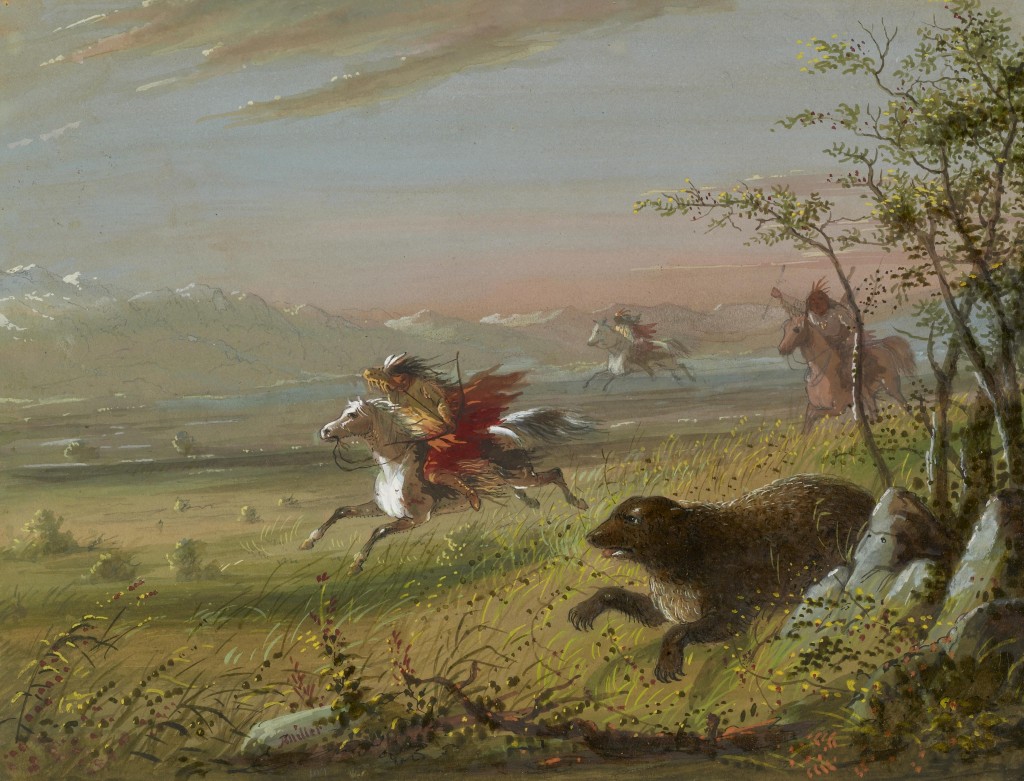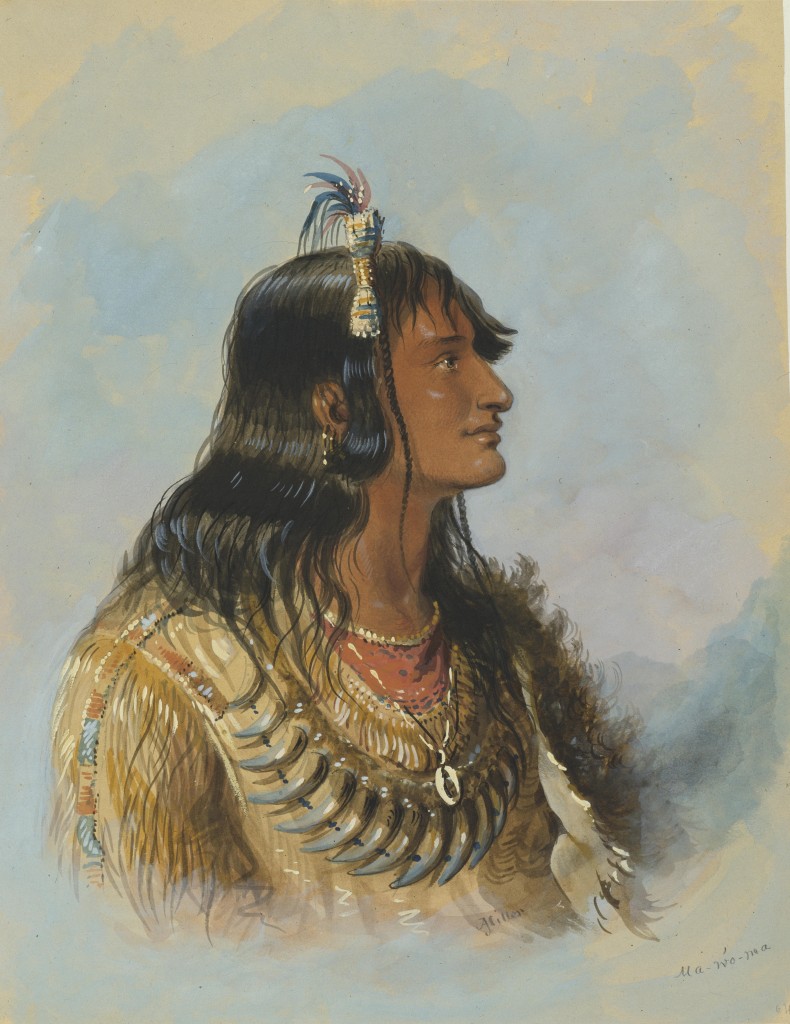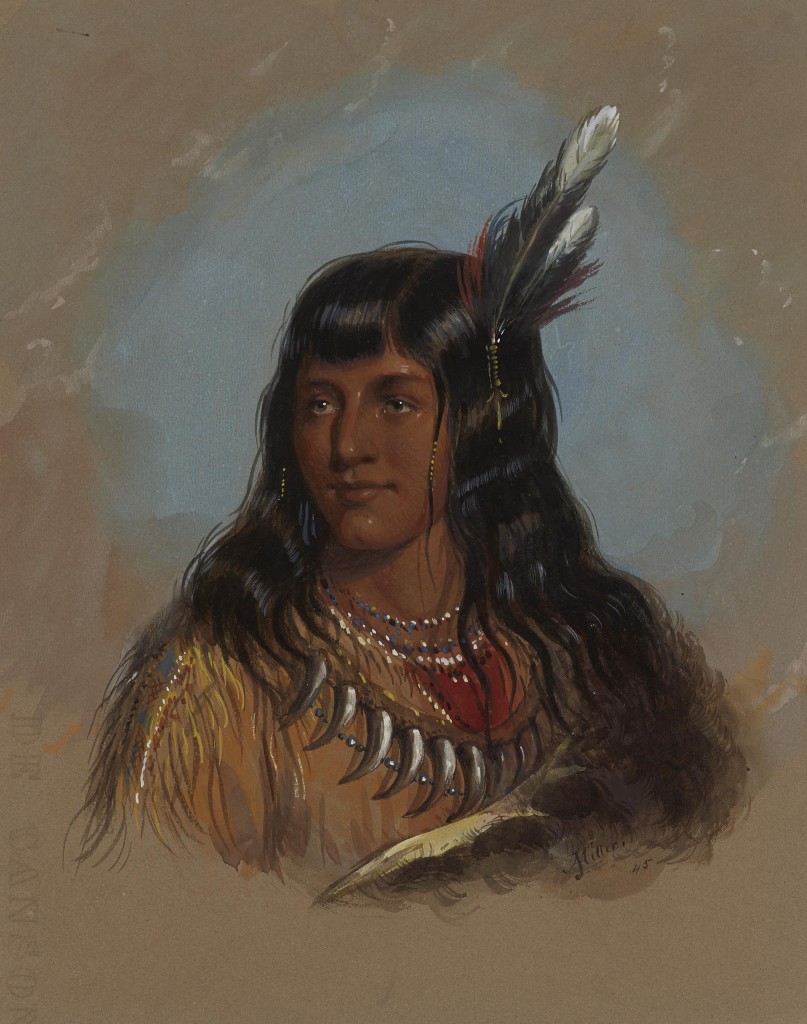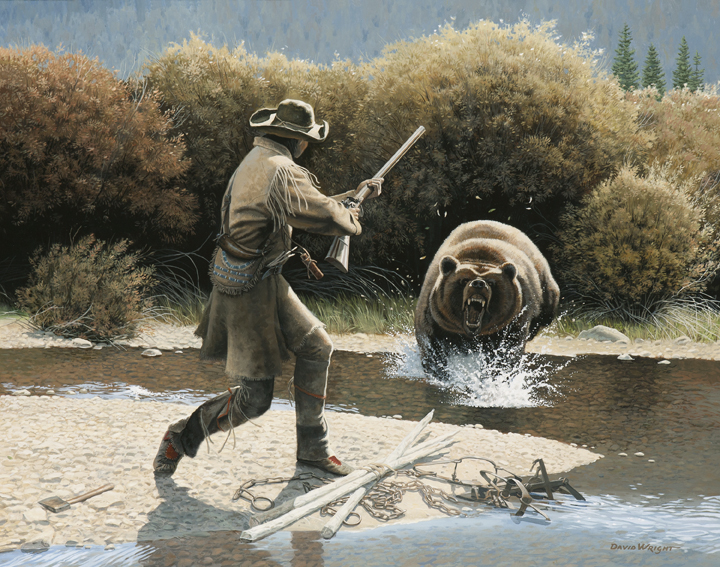
Notes from Alfred Jacob Miller journal:
“The Indians have just driven the bear from his covert among some wild cherry bushes, which fruit is decidedly one of his weaknesses; of it he is remarkably fond. They are preparing to run him, giving him at the same time a wide berth, knowing very well the formidable qualities of the brute they have to deal with. As an arrow sometimes fails to pierce his body, owing to thick matted hair, they aim usually at the head, the most vulnerable part.
The great narratives at the camp fire are in connection with this animal; -one of the most singular was that of a man named Glass; -he with some companions on foot shot at a bear but only wounded him and now a chase commenced; he called to the other to run, and in doing so himself, tripped and fell; by the time he arose and looked around, the beast confronted him. As he closed on him, G—- never losing his presence of mind discharged his pistol full into the body of the animal, at the same moment that the other fixed his claws deep into his flesh and rolled him to the ground. By the time his companions reached the spot, he was covered with blood, and ht e bear dead lying upon his body, -both appeared dead. The others pulled the bear from him, took his arms and returned to camp. Months elapsed; -the company was returning to the Fort; -they saw a man slowly approaching by the banks of the river, as he came nearer their eyes rested on a cadaverous figure with a head so disfigured as to be un-known. The astonishment of the party may be conceived when they heard a well-known voice call out, “Hallo! Bill! you thought I was ‘gone under’, didn’t you? hand over my horse and ‘fixens’. I ain’t dead yet by a cussed sight.” It was the veritable Glass whom they left with the bear. IN his recital he stated that after a time he recovered his senses & fed on the bear; as soon as he could gain strength sufficient, he took a supply of the meat with him, and on it and berries subsisted until he reached the Fort, a distance of 60 miles.”
–The West of Alfred Jacob Miller, from the Notes and Water Colors in the WALTERS ART GALLERY, with an account of the artist by Marvin C. Ross
To view more images of Alfred Jacob Miller paintings visit:

Notes from Alfred Jacob Miller journal:
Ma-wo-ma
The translation of this word into the vernacular is “Little Chief” – it was somewhat of a misnomer, the subject of it standing nearly six feet in his moccasins. It did not apply in any instance,- for he was a chief of about 3,000 Snake Indians, and decidedly in every sense superior to any Indian that we had met with. He was a man of high principle, in whom you could place confidence. When our Commander on a former journey had difficulty with the Indians, and lost all his horses, this Indian exerted himself in his behalf and recovered the most of them:- he stated also to him that if he had placed himself under his (Ma-wo-ma’s) protection in the first place, he would not have lost any. In his drawing some bulletins of battles for me, such as thy send to their colleagues, I noticed that all four of the legs of the horses were on one side; this arose from a want of knowledge of perspective. He also colored them with the stick end of a brush instead of the hair end,- not probably having seen before an article of the kind.”
–The West of Alfred Jacob Miller, from the Notes and Water Colors in the WALTERS ART GALLERY, with an account of the artist by Marvin C. Ross
To view more images of Alfred Jacob Miller paintings visit:

Notes from Alfred Jacob Miller journal:
Si-roc-u-an-tua
About 22 years of age, son of the Chief Ma-wo-ma. This Indian was an admirable specimen of the Snakes. His form, -straight as an arrow, and a carriage of natural grace, -that no dancing master could impart. It was impossible to look at him without admiration. He had already distinguished himself in battle, and wore a trophy round his neck of his prowess in hunting the grizzly-bear, this was a necklace composed of the claws of that formidable brute. A lock of hair was worn in front cut square above his eyes, and the que worn behind his head, extending in length to the bend of his knee-joint ornamented with huge brass rings at intervals. His bearing was that of a prince-courageous and self-reliant. His aspirations seemed to be like that invoked by the Poet;-
Thy spirit Independence, let me share, Lord of the lion-heart and eagle eye, They steps I follow with my bosom bare, Nor heeds the storm that howls along the sky.
– The West of Alfred Jacob Miller, from the Notes and Water Colors in the WALTERS ART GALLERY, with an account of the artist by Marvin C. Ross
To view more images of Alfred Jacob Miller paintings visit:

“Caught Off Guard”
Below is the inspiration behind the painting by Artist David Wright:
“Because I’m familiar with the story of Hugh Glass as we all are, I’ve often considered doing a painting of a mountain man encounter with a “great white bear” (as were mentioned in the journals of Lewis and Clark and other frontiersmen). I’ve thought about make-up of the subject matter, the composition, just what would make an interesting story to put in a painting. But a couple years ago a conversation with a friend give me the idea of the painting as it eventually emerged – that is, a close up action filled encounter of a hunter with a bear bursting from the willows. His story was simple, a direct experience that didn’t culminate as my painting does – in a direct confrontation with a bear but a rather a thought provoking – “what if” had things changed in a heartbeat and the bear was indeed there at that spot.
Here it is. He was fishing a small creek in Montana, when he had to crouch down to get through some willows bordering the creek. As he looked down, he noticed a large bear track in the sand. It was fascinating to see one up close, he told me. But then it dawned on him that the track was slowly filling with water which put a new light on the existence of a bear track in the sand. And an immediate need to slowly back out of the willows quickly (if you can do both). Fortunately the bear didn’t materialize and the story had a happy ending.
His story provoked me to do the painting – one of that depicts an incident that had to take place many times though the years to hunters, trappers, fishermen, and even back packers. Bears sleeping in willows being surprised and attacking. In my case, I depicted a mountain man during the fur trade with a chance for one shot to defend himself. The story is one that has been told many times but outcome is left to the viewer.”
